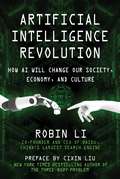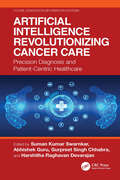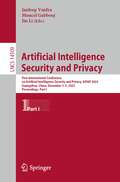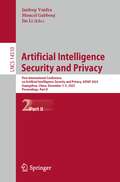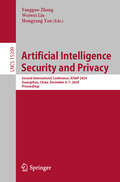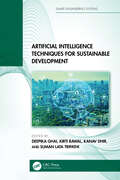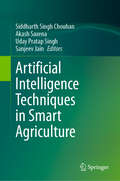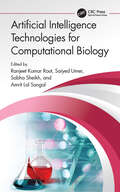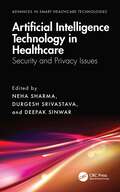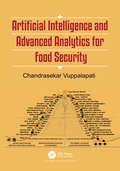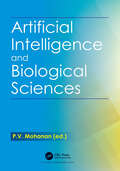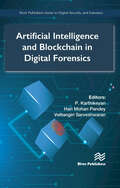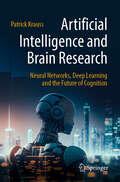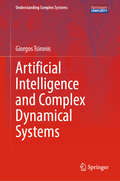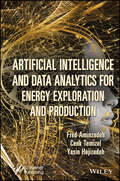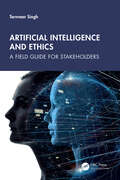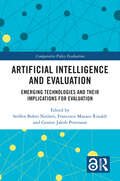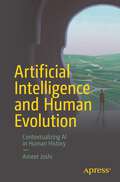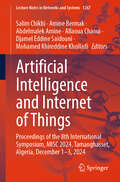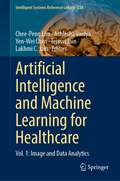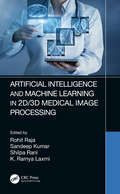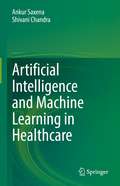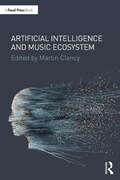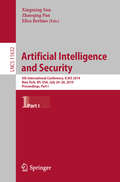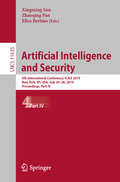- Table View
- List View
Artificial Intelligence Revolution: How AI Will Change our Society, Economy, and Culture
by Robin LiThe co-founder of Baidu explains how AI will transform human livelihood, from our economy and financial systems down to our daily lives. Written by Baidu cofounder Robin Li and prefaced by award-winning sci-fi writer Cixin Liu (author of The Three-Body Problem), Artificial Intelligence Revolution introduces Baidu&’s teams of top scientists and management as pioneers of movement toward AI. The book covers many of the latest AI-related ideas and technological developments, such as: Computational abilityBig data resourcesSetting the basic standards of AI in research and developmentAn introduction to the &“super brain&”Intelligent manufacturingDeep learningL4 automated vehiclesSmart finance The book describes the emergence of a &“smart&” society powered by technology and reflects on the challenges humanity is about to face. Li covers the most pressing AI-related ideas and technological developments, including: Will artificial intelligence replace human workers, and in what sectors of the economy? How will it affect healthcare and finance? How will daily human life change? Robin Li&’s Artificial Intelligence Revolution addresses these questions and more from the perspective of a pioneer of AI development. It's a must-read for anyone concerned about the emergence of a &“smart&” society powered by technology and the challenges humanity is about to face.
Artificial Intelligence Revolutionizing Cancer Care: Precision Diagnosis and Patient-Centric Healthcare (Future Generation Information Systems)
by Suman Kumar Swarnkar Gurpreet Singh Chhabra Abhishek Guru Harshitha Raghavan DevarajanIn the ever-evolving landscape of cancer treatment, the fusion of artificial intelligence (AI) with medical science marks a groundbreaking shift toward more precise, efficient, and personalized healthcare. Artificial Intelligence Revolutionizing Cancer Care: Precision Diagnosis and Patient-Centric Healthcare delves into the transformative power of AI, offering a comprehensive exploration of its role in enhancing cancer diagnosis, treatment, and patient management. This edited volume brings together leading experts and researchers who illuminate the latest advancements in AI technologies applied to oncology. From machine learning algorithms that predict cancer progression to sophisticated imaging techniques that improve diagnostic accuracy, this book covers a spectrum of innovations reshaping cancer care. Key highlights include precision diagnosis, uncovering how AI-driven tools are revolutionizing the early detection and accurate classification of various cancer types, leading to better patient outcomes; patient-centric approaches, exploring the shift toward personalized medicine, where AI tailors treatment protocols to individual patient profiles, ensuring more effective and targeted therapies; and ethical and practical considerations, gaining insights into the ethical, practical, and regulatory challenges of integrating AI in healthcare, emphasizing the need for patient privacy and data security. Additionally, the book looks ahead to the potential future applications of AI in oncology, including predictive analytics, robotic surgery, and beyond. Artificial Intelligence Revolutionizing Cancer Care is an essential resource for medical professionals, researchers, and students seeking to understand the intersection of AI and oncology. It offers a visionary perspective on how cutting-edge technology is poised to enhance patient care and transform the fight against cancer.This book focuses on the critical intersection of artificial intelligence and cancer diagnosis within the healthcare sector emphasizes the real-world impact of artificial intelligence in improving cancer detection, treatment, and overall patient care covers artificial intelligence algorithms, machine learning techniques, medical image analysis, predictive modeling, and patient care applications explores how artificial intelligence technologies enhance the patient’s experience, resulting in better outcomes and reduced healthcare disparities provides readers with an understanding of the mathematics underpinning machine learning models, including decision trees, support vector machines, and deep neural networks It is primarily written for senior undergraduates, graduate students, and academic researchers in the fields of electrical engineering, electronics and communications engineering, computer science and engineering, biomedical engineering, and information technology.
Artificial Intelligence Security and Privacy: First International Conference on Artificial Intelligence Security and Privacy, AIS&P 2023, Guangzhou, China, December 3–5, 2023, Proceedings, Part I (Lecture Notes in Computer Science #14509)
by Jin Li Moncef Gabbouj Jaideep VaidyaThis two-volume set LNCS 14509-14510, constitutes the refereed proceedings of the First International Conference on Artificial Intelligence Security and Privacy, AIS&P 2023, held in Guangzhou, China, during December 3–5, 2023.The 40 regular papers and 23 workshop papers presented in this two-volume set were carefully reviewed and selected from 115 submissions.Topics of interest include, e.g., attacks and defence on AI systems; adversarial learning; privacy-preserving data mining; differential privacy; trustworthy AI; AI fairness; AI interpretability; cryptography for AI; security applications.
Artificial Intelligence Security and Privacy: First International Conference on Artificial Intelligence Security and Privacy, AIS&P 2023, Guangzhou, China, December 3–5, 2023, Proceedings, Part II (Lecture Notes in Computer Science #14510)
by Jin Li Moncef Gabbouj Jaideep VaidyaThis two-volume set LNCS 14509-14510, constitutes the refereed proceedings of the First International Conference on Artificial Intelligence Security and Privacy, AIS&P 2023, held in Guangzhou, China, during December 3–5, 2023.The 40 regular papers and 23 workshop papers presented in this two-volume set were carefully reviewed and selected from 115 submissions. Topics of interest include, e.g., attacks and defence on AI systems; adversarial learning; privacy-preserving data mining; differential privacy; trustworthy AI; AI fairness; AI interpretability; cryptography for AI; security applications.
Artificial Intelligence Security and Privacy: Second International Conference, AIS&P 2024, Guangzhou, China, December 6-7, 2024, Proceedings (Lecture Notes in Computer Science #15399)
by Fangguo Zhang Hongyang Yan Weiwei LinThis book constitutes the refereed proceedings of the Second International Conference on Artificial Intelligence Security and Privacy, AIS&P 2024, held in Guangzhou, China, during December 6-7, 2024. The 14 full papers included in this book were carefully reviewed and selected from 47 submissions. The papers help to researchers to exchange latest research progress in all areas such as artificial intelligence, security and privacy, and their applications.
Artificial Intelligence Techniques for Sustainable Development (Smart Engineering Systems: Design and Applications)
by Suman Lata Tripathi Kanav Dhir Deepika Ghai Kirti RawalHow can the efficiency of the algorithms be increased with a lesser number of computations as well as optimized with the resources for cost-effective solutions? Artificial Intelligence Techniques for Sustainable Development provides an answer. Further, it discusses important concepts such as green communication network design and implementation for the Internet of Things ecosystem, green computing in network security, and artificial intelligence models for remote sensing applications.Key features: Presents the latest tools and techniques in developing solutions intended for resource utilization, energy efficiency, and human and environmental health Highlights the advancement in electronics and communication technology for green applications Covers smart energy harvesting/charging and power management techniques using machine learning Explains green communication network design and implementation for the Internet of Things ecosystem, and green computing in network security Illustrates prediction models for carbon emission and sequestration, environmental health, and climate change The book is aimed at senior undergraduates, graduate students, and academic researchers in the fields of electrical engineering, electronics, and communications engineering, computer science and engineering, environmental engineering, and biomedical engineering.
Artificial Intelligence Techniques in Smart Agriculture
by Sanjeev Jain Siddharth Singh Chouhan Uday Pratap Singh Akash SaxenaThis edited volume explores the integration of artificial intelligence to improve crop production. It addresses the critical need for intelligent crop management in light of the world's escalating population. Encompassing a spectrum of technologies, including computer vision, image processing, soft computing, machine learning, and deep learning, the book explores advancements in decision-making systems. It integrates data science methodologies, Internet of Things, wireless communications, and a range of sensors and actuators to provide precise, timely, and cost-effective solutions to agricultural challenges, ultimately enhancing both the quality and quantity of crop yields. The book empowers its audience to direct their efforts towards designing models and prototypes that benefit society and the environment, making it an indispensable resource for those eager to shape the future of intelligent agriculture. It serves as a comprehensive guide for students, scholars, and academicians keen on delving into the transformative field of artificial intelligence in agriculture. Researchers, scientists, and field experts will find invaluable insights to guide their exploration and contribution to this domain.
Artificial Intelligence Technologies for Computational Biology
by Ranjeet Kumar Rout Saiyed Umer Sabha Sheikh Amrit Lal SangalThis text emphasizes the importance of artificial intelligence techniques in the field of biological computation. It also discusses fundamental principles that can be applied beyond bio-inspired computing.It comprehensively covers important topics including data integration, data mining, machine learning, genetic algorithms, evolutionary computation, evolved neural networks, nature-inspired algorithms, and protein structure alignment. The text covers the application of evolutionary computations for fractal visualization of sequence data, artificial intelligence, and automatic image interpretation in modern biological systems.The text is primarily written for graduate students and academic researchers in areas of electrical engineering, electronics engineering, computer engineering, and computational biology.This book:• Covers algorithms in the fields of artificial intelligence, and machine learning useful in biological data analysis.• Discusses comprehensively artificial intelligence and automatic image interpretation in modern biological systems.• Presents the application of evolutionary computations for fractal visualization of sequence data.• Explores the use of genetic algorithms for pair-wise and multiple sequence alignments.• Examines the roles of efficient computational techniques in biology.
Artificial Intelligence Technology in Healthcare: Security and Privacy Issues (Advances in Smart Healthcare Technologies)
by Neha Sharma Deepak Sinwar Durgesh SrivastavaArtificial Intelligence Technology in Healthcare: Security and Privacy Issues focuses on current issues with patients’ privacy and data security including data breaches in healthcare organizations, unauthorized access to patients’ information, and medical identity theft. It explains recent breakthroughs and problems in deep learning security and privacy issues, emphasizing current state-of-the-art methods, methodologies, implementation, attacks, and countermeasures. It examines the issues related to developing artifiicial intelligence (AI)-based security mechanisms which can gather or share data across several healthcare applications securely and privately. Features: Combines multiple technologies (i.e., Internet of Things [IoT], Federated Computing, and AI) for managing and securing smart healthcare systems. Includes state-of-the-art machine learning, deep learning techniques for predictive analysis, and fog and edge computing-based real-time health monitoring. Covers how to diagnose critical diseases from medical imaging using advanced deep learning-based approaches. Focuses on latest research on privacy, security, and threat detection on COVID-19 through IoT. Illustrates initiatives for research in smart computing for advanced healthcare management systems. This book is aimed at researchers and graduate students in bioengineering, artificial intelligence, and computer engineering.
Artificial Intelligence and Advanced Analytics for Food Security
by Chandrasekar VuppalapatiClimate change, increasing population, food-versus-fuel economics, pandemics, etc. pose a threat to food security to unprecedented levels. It has fallen upon the practitioners of agriculture and technologists of the world to innovate and become more productive to address the multi-pronged food security challenges. Agricultural innovation is key to managing food security concerns. The infusion of data science, artificial intelligence (AI), advanced analytics, satellites data, geospatial data, climatology, sensor technologies, and climate modeling with traditional agricultural practices such as soil engineering, fertilizers use, and agronomy are some of the best ways to achieve this. Data science helps farmers to unravel patterns in fertilizer pricing, equipment usage, transportation and storage costs, yield per hectare, and weather trends to better plan and spend resources. AI enables farmers to learn from fellow farmers to apply best techniques that are transferred learning from AI to improve agricultural productivity and to achieve financial sustainability. Sensor technologies play an important role in getting real-time farm field data and provide feedback loops to improve overall agricultural practices and can yield huge productivity gains. Advanced Analytics modeling is essential software technique that codifies farmers’ tacit knowledge such as better seed per soil, better feed for dairy cattle breed, or production practices to match weather pattern that was acquired over years of their hard work to share with worldwide farmers to improve overall production efficiencies, the best antidote to food security issue. In addition to the paradigm shift, economic sustainability of small farms is a major enabler of food security. The book reviews all these technological advances and proposes macroeconomic pricing models that data mines macroeconomic signals and the influence of global economic trends on small farm sustainability to provide actionable insights to farmers to avert any financial disasters due to recurrent economic crises.
Artificial Intelligence and Biological Sciences
by P. V. MohananAdvancements of AI in medical and biological sciences have opened new ways for drug development. Novel therapeutic molecules and their target action can be easily predicted and can be modified. AI helps in disease detection and diagnosis faster. The breakthrough of AI is made especially in the area of personalized precision medicine, host-pathogen interaction and predictive epidemiology. These approaches could help in faster decision-making with minimal errors that can improve risk analysis, especially disease diagnosis and selecting treatment strategy. In agricultural practices, an exact combination of fertilizers, pesticides, herbicides, soil management, water requirement analysis, yield prediction and overall crop management can be modified by implementing AI interventions. AI could provide a better improvement in agriculture, medical research, pharmaceuticals and bio-based industries for a sustainable life.The key features of this book are: AI in medical Sciences, biotechnology and drug discovery; Application of AI in Digital Pathology, cytology and bioinformatics; Overview of AI, Machine Learning and Deep Learning; Impact of Artificial Intelligence in Society; Artificial Intelligence in Pharmacovigilance; and Ethics in Artificial Intelligence. The volume aims to comprehensively cover the application of AI in biological sciences. It is a collection of contributions from different authors who have several years of experience in their specific areas. The book will be useful for pharma companies, CROs, product developers, students, researchers, academicians, policymakers and practitioners.
Artificial Intelligence and Blockchain in Digital Forensics (River Publishers Series in Digital Security and Forensics)
by P. Karthikeyan Hari Mohan Pandey Velliangiri SarveshwaranDigital forensics is the science of detecting evidence from digital media like a computer, smartphone, server, or network. It provides the forensic team with the most beneficial methods to solve confused digital-related cases. AI and blockchain can be applied to solve online predatory chat cases and photo forensics cases, provide network service evidence, custody of digital files in forensic medicine, and identify roots of data scavenging. The increased use of PCs and extensive use of internet access, have meant easy availability of hacking tools. Over the past two decades, improvements in the information technology landscape have made the collection, preservation, and analysis of digital evidence extremely important. The traditional tools for solving cybercrimes and preparing court cases are making investigations difficult. We can use AI and blockchain design frameworks to make the digital forensic process efficient and straightforward. AI features help determine the contents of a picture, detect spam email messages and recognize swatches of hard drives that could contain suspicious files. Blockchain-based lawful evidence management schemes can supervise the entire evidence flow of all of the court data. This book provides a wide-ranging overview of how AI and blockchain can be used to solve problems in digital forensics using advanced tools and applications available on the market.
Artificial Intelligence and Brain Research: Neural Networks, Deep Learning and the Future of Cognition
by Patrick KraussHow does artificial intelligence (AI) work and are there parallels to the human brain? What do natural and artificial intelligence have in common, and what are the differences? Is the brain nothing more than a biological computer? What are neural networks and how can the term deep learning be explained simply?Since the cognitive revolution in the middle of the last century, AI and brain research have been closely intertwined. There have been several spectacular breakthroughs in the field of AI in recent years, from alphaGo to DALL-E 2 and ChatGPT, which were completely unthinkable until recently. However, researchers are already working on the innovations of tomorrow, such as hybrid machine learning or neuro-symbolic AI. But what does this actually mean?Based on current research findings and exciting practical examples, this non-fiction book provides an understandable introduction to the basics and challenges of these fascinating disciplines. You will learn what neuroscience and psychology know about how the brain works and how artificial intelligence works. You will also learn how AI has revolutionized our understanding of the brain and how findings from brain research are used in computer science to further develop AI algorithms. Discover the fascinating world of these two disciplines. Find out why artificial intelligence and brain research are two sides of the same coin and how they will shape our future.
Artificial Intelligence and Complex Dynamical Systems (Understanding Complex Systems)
by Giorgos TsironisThis book serves as a comprehensive introduction to nonlinear complex systems through the application of machine learning methods. Artificial intelligence (AI) has affected the foundations of scientific discovery, and can therefore lend itself to developing a better understanding of the unpredictable nature of complex dynamical systems and to predict their future evolution. Utilizing Python code, this book teaches and applies machine learning to topics such as chaotic dynamics and time-series analysis, solitons, breathers, chimeras, nonlinear localization, biomolecular dynamics, and wave propagation in the heart. The consistent integration of methods and models allow for readers to develop a necessary intuition on how to handle complexity through AI. This textbook contains a wealth of expository material, code, and example problems to support and organize academic coursework, allowing the technical nature of these areas of study to become highly accessible. Requiring only a basic background in mathematics and coding in Python, this book is an essential text for a wide array of advanced undergraduate or graduate students in the applied sciences interested in complex systems through the lens of machine learning.
Artificial Intelligence and Data Analytics for Energy Exploration and Production
by Fred Aminzadeh Cenk Temizel Yasin HajizadehARTIFICAL INTELLIGENCE AND DATA ANALYTICS FOR ENERGY EXPLORATION AND PRODUCTION This groundbreaking new book is written by some of the foremost authorities on the application of data science and artificial intelligence techniques in exploration and production in the energy industry, covering the most comprehensive and updated new processes, concepts, and practical applications in the field. The book provides an in-depth treatment of the foundations of Artificial Intelligence (AI) Machine Learning, and Data Analytics (DA). It also includes many of AI-DA applications in oil and gas reservoirs exploration, development, and production. The book covers the basic technical details on many tools used in “smart oil fields”. This includes topics such as pattern recognition, neural networks, fuzzy logic, evolutionary computing, expert systems, artificial intelligence machine learning, human-computer interface, natural language processing, data analytics and next-generation visualization. While theoretical details will be kept to the minimum, these topics are introduced from oil and gas applications viewpoints. In this volume, many case histories from the recent applications of intelligent data to a number of different oil and gas problems are highlighted. The applications cover a wide spectrum of practical problems from exploration to drilling and field development to production optimization, artificial lift, and secondary recovery. Also, the authors demonstrate the effectiveness of intelligent data analysis methods in dealing with many oil and gas problems requiring combining machine and human intelligence as well as dealing with linguistic and imprecise data and rules.
Artificial Intelligence and Ethics: A Field Guide for Stakeholders
by Tarnveer SinghArtificial Intelligence and Ethics is a general and wide-ranging survey of the benefits and ethical dilemmas of artificial intelligence (AI). The rise of AI and super-intelligent AI has created an urgent need to understand the many and varied ethical issues surrounding the technologies and applications of AI. This book lays a path towards the benefits and away from potential risks. It includes over thirty short chapters covering the widest array of topics from generative AI to superintelligence, from regulation to transparency, and from cybersecurity to risk management. Written by an award-winning Chief Information Security Officer (CISO) and experienced Technology Leader with two decades of industry experience, the book includes real-life examples and up-to-date references. The book will be of particular interest to business stakeholders, including executives, scientists, ethicists and policymakers, considering the complexities of AI and how to navigate these.
Artificial Intelligence and Evaluation: Emerging Technologies and Their Implications for Evaluation (Comparative Policy Evaluation)
by Steffen Bohni Nielsen, Francesco Mazzeo Rinaldi and Gustav Jakob PeterssonArtificial Intelligence and Evaluation: Emerging Technologies and Their Implications for Evaluation is a groundbreaking exploration of how the landscape of program evaluation will be redefined by artificial intelligence and other emerging digital technologies.In an era where digital technologies and artificial intelligence (AI) are rapidly evolving, this book presents a pivotal resource for evaluators navigating the transformative intersection of their practice and cutting-edge technology. Addressing the dual dimensions of how evaluations are conducted and what is evaluated, a roster of distinguished contributors illuminate the impact of AI on program evaluation methodologies. Offering a discerning overview of various digital technologies, their promises and perils, they carefully dissect the implications for evaluative processes and debate how evaluators must be equipped with the requisite skills to harness the full potential of AI tools. Further, the book includes a number of compelling use cases, demonstrating the tangible applications of AI in diverse evaluation scenarios. The use cases range from the application of GIS data to advanced text analytics. As such, this book provides evaluators with inspirational cases on how to apply AI in their practice as well as what pitfalls one must look out for.Artificial Intelligence and Evaluation is an indispensable guide for evaluators seeking to not only adapt to but thrive in the dynamic landscape of evaluation practices reshaped by the advent of artificial intelligence.The Open Access version of this book, available at http://www.taylorfrancis.com, has been made available under a Creative Commons Attribution-Non Commercial-No Derivatives 4.0 license.
Artificial Intelligence and Human Evolution: Contextualizing AI in Human History
by Ameet JoshiThis book explores, from a high level, the parallels between the evolution of humans and the evolution of machines. The book reviews practical questions about the future of AI but also engages in philosophical discussions about what machine intelligence could mean for the human experience.The book focuses on what is intelligence and what separates intelligent species from non-so-intelligent ones. It concludes this section with the description of true nature of humanintelligence can be. We discuss how we looked at machines few hundred years back and how their definition and the expectations from them has changed over time. We will consider when and how machines became intelligent and then explore in depth he latest developments in artificial intelligence with explanation of deep learning technology and humanlike chat interface provided with products like ChatGPT. We will define both human intelligence and artificial intelligence and the distinction between the two.In the third and final section of the book, we will focus on near- and longer-term futures with widespread use of machine intelligence, making the whole ambient environment that we will live in intelligent How is this going to change human lives, and what parts of human life will be encroached with machines and their intelligence? We will explore how the job market will look with some jobs being taken by machines, and if this is overall a positive or negative change. What You Will LearnHow human intelligence is connected with artificial intelligence as well as the differencesHow AI is going to change our lives in the coming years, decades and centuriesAn explanation of deep learning technology and humanlike chat interface provided with products like ChatGPTWho This Book is ForReaders looking to contextualize the evolution of artificial intelligence in human history
Artificial Intelligence and Internet of Things: Proceedings of the 8th International Symposium, MISC 2024, Tamanghasset, Algeria, December 1-3, 2024 (Lecture Notes in Networks and Systems #1267)
by Salim Chikhi Abdelmalek Amine Allaoua Chaoui Mohamed Khireddine Kholladi Djamel Eddine Saidouni Amine BermakThis book offers a cutting-edge exploration of key advancements in artificial intelligence, IoT, data science, and their transformative impact on industries, particularly health care, in a rapidly evolving technological landscape. Readers will discover how AI and machine learning drive innovations, from detecting anomalies in satellite systems to enhancing medical diagnostics and treatment precision. With a focus on real-world applications, the book delves into the integration of IoT systems and cloud computing to streamline business operations and improve efficiency. It also introduces groundbreaking data science techniques for analysis and prediction, making it a valuable resource for professionals, researchers, and students. Designed for those looking to understand and harness the power of modern technology, this book provides insights that are both practical and forward-looking, equipping readers to address today’s challenges and shape the future.
Artificial Intelligence and Machine Learning for Healthcare: Vol. 1: Image and Data Analytics (Intelligent Systems Reference Library #228)
by Lakhmi C. Jain Yen-Wei Chen Chee-Peng Lim Ashlesha Vaidya Tejasvi JainArtificial intelligence (AI) and machine learning (ML) have transformed many standard and conventional methods in undertaking health and well-being issues of humans. AL/ML-based systems and tools play a critical role in this digital and big data era to address a variety of medical and healthcare problems, improving treatments and quality of care for patients. This edition on AI and ML for healthcare consists of two volumes. The first presents selected AI and ML studies on medical imaging and healthcare data analytics, while the second unveils emerging methodologies and trends in AI and ML for delivering better medical treatments and healthcare services in the future.In this first volume, progresses in AI and ML technologies for medical image, video, and signal processing as well as health information and data analytics are presented. These selected studies offer readers theoretical and practical knowledge and ideas pertaining to recent advances in AI and ML for effective and efficient image and data analytics, leading to state-of-the-art AI and ML technologies for advancing the healthcare sector.
Artificial Intelligence and Machine Learning in 2D/3D Medical Image Processing
by Sandeep Kumar Rohit Raja Shilpa Rani K. Ramya LaxmiDigital images have several benefits, such as faster and inexpensive processing cost, easy storage and communication, immediate quality assessment, multiple copying while preserving quality, swift and economical reproduction, and adaptable manipulation. Digital medical images play a vital role in everyday life. Medical imaging is the process of producing visible images of inner structures of the body for scientific and medical study and treatment as well as a view of the function of interior tissues. This process pursues disorder identification and management. Medical imaging in 2D and 3D includes many techniques and operations such as image gaining, storage, presentation, and communication. The 2D and 3D images can be processed in multiple dimensions. Depending on the requirement of a specific problem, one must identify various features of 2D or 3D images while applying suitable algorithms. These image processing techniques began in the 1960s and were used in such fields as space, clinical purposes, the arts, and television image improvement. In the 1970s, with the development of computer systems, the cost of image processing was reduced and processes became faster. In the 2000s, image processing became quicker, inexpensive, and simpler. In the 2020s, image processing has become a more accurate, more efficient, and self-learning technology. This book highlights the framework of the robust and novel methods for medical image processing techniques in 2D and 3D. The chapters explore existing and emerging image challenges and opportunities in the medical field using various medical image processing techniques. The book discusses real-time applications for artificial intelligence and machine learning in medical image processing. The authors also discuss implementation strategies and future research directions for the design and application requirements of these systems. This book will benefit researchers in the medical image processing field as well as those looking to promote the mutual understanding of researchers within different disciplines that incorporate AI and machine learning. FEATURES Highlights the framework of robust and novel methods for medical image processing techniques Discusses implementation strategies and future research directions for the design and application requirements of medical imaging Examines real-time application needs Explores existing and emerging image challenges and opportunities in the medical field
Artificial Intelligence and Machine Learning in Healthcare
by Ankur Saxena Shivani ChandraThis book reviews the application of artificial intelligence and machine learning in healthcare. It discusses integrating the principles of computer science, life science, and statistics incorporated into statistical models using existing data, discovering patterns in data to extract the information, and predicting the changes and diseases based on this data and models. The initial chapters of the book cover the practical applications of artificial intelligence for disease prognosis & management. Further, the role of artificial intelligence and machine learning is discussed with reference to specific diseases like diabetes mellitus, cancer, mycobacterium tuberculosis, and Covid-19. The chapters provide working examples on how different types of healthcare data can be used to develop models and predict diseases using machine learning and artificial intelligence. The book also touches upon precision medicine, personalized medicine, and transfer learning, with the real examples. Further, it also discusses the use of machine learning and artificial intelligence for visualization, prediction, detection, and diagnosis of Covid -19. This book is a valuable source of information for programmers, healthcare professionals, and researchers interested in understanding the applications of artificial intelligence and machine learning in healthcare.
Artificial Intelligence and Music Ecosystem
by Martin ClancyArtificial Intelligence and Music Ecosystem highlights the opportunities and rewards associated with the application of AI in the creative arts. Featuring an array of voices, including interviews with Jacques Attali, Holly Herndon and Scott Cohen, this book offers interdisciplinary approaches to pressing ethical and technical questions associated with AI. Considering the perspectives of developers, students and artists, as well as the wider themes of law, ethics and philosophy, Artificial Intelligence and Music Ecosystem is an essential introduction for anyone interested in the impact of AI on music, including those studying and working in the creative arts.
Artificial Intelligence and Security: 5th International Conference, ICAIS 2019, New York, NY, USA, July 26-28, 2019, Proceedings, Part I (Lecture Notes in Computer Science #11632)
by Elisa Bertino Xingming Sun Zhaoqing PanThe 4-volume set LNCS 11632 until LNCS 11635 constitutes the refereed proceedings of the 5th International Conference on Artificial Intelligence and Security, ICAIS 2019, which was held in New York, USA, in July 2019. The conference was formerly called “International Conference on Cloud Computing and Security” with the acronym ICCCS.The total of 230 full papers presented in this 4-volume proceedings was carefully reviewed and selected from 1529 submissions. The papers were organized in topical sections as follows: Part I: cloud computing; Part II: artificial intelligence; big data; and cloud computing and security; Part III: cloud computing and security; information hiding; IoT security; multimedia forensics; and encryption and cybersecurity; Part IV: encryption and cybersecurity.
Artificial Intelligence and Security: 5th International Conference, ICAIS 2019, New York, NY, USA, July 26–28, 2019, Proceedings, Part IV (Lecture Notes in Computer Science #11635)
by Elisa Bertino Xingming Sun Zhaoqing PanThe 4-volume set LNCS 11632 until LNCS 11635 constitutes the refereed proceedings of the 5th International Conference on Artificial Intelligence and Security, ICAIS 2019, which was held in New York, USA, in July 2019. The conference was formerly called “International Conference on Cloud Computing and Security” with the acronym ICCCS.The total of 230 full papers presented in this 4-volume proceedings was carefully reviewed and selected from 1529 submissions. The papers were organized in topical sections as follows: Part I: cloud computing; Part II: artificial intelligence; big data; and cloud computing and security; Part III: cloud computing and security; information hiding; IoT security; multimedia forensics; and encryption and cybersecurity; Part IV: encryption and cybersecurity.
